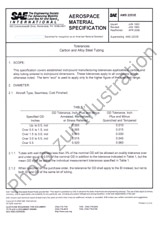Wir benötigen Ihre Einwilligung zur Verwendung der einzelnen Daten, damit Sie unter anderem Informationen zu Ihren Interessen einsehen können. Klicken Sie auf "OK", um Ihre Zustimmung zu erteilen.

Informationen über die Norm:
Bezeichnung normen: SAE J469
Ausgabedatum normen: 1.12.2017
SKU: NS-807160
Land: Amerikanische technische Norm
Kategorie: Technische Normen SAE
Die Annotation des Normtextes SAE J469 :
Because of the drastic chilling involved in die casting and the fact that the solid solubilities of both aluminum and copper in zinc change with temperature, these alloys are subject to some aging changes, one of which is a dimensional change. Both of the alloys undergo a slight shrinkage after casting, which at room temperature is about two-thirds complete in five weeks. It is possible to accelerate this shrinkage by a stabilizing anneal, after which no further changes occur. The recommended stabilizing anneal is 3 to 6 h at 100 °C (212 °F), or 5 to 10 h at 85 °C (185 °F), or 10 to 20 h at 70 °C (158 °F). The time in each case is measured from the time at which the castings reach the annealing temperature. The parts may be air cooled after annealing. Such a treatment will cause a shrinkage (0.0004 in per in) of about two-thirds of the total, and the remaining shrinkage will occur at room temperature during the subsequent few weeks. Stabilizing results in a decrease in dimensions of about 0.0005 in per in from the original size of the casting. Stabilizing is, of course, unnecessary if the machine or fitting operations can be delayed until the castings have aged five weeks at room temperature.
When exposed to stagnant moisture or condensation with limited access to oxygen, a nonuniform type of corrosion may occur on zinc die castings, which often results in the formation of a bulky film of white corrosion products. This may hinder the operation of such parts as automobile lock cylinders, fuel pumps, and carburetors, and in severe cases result in rather rapid loss of zinc. Various types of chromate films are available to satisfactorily overcome this condition.
The same electroplating or enameling procedure is used with both alloys. Organic finishes are quite variable in their ability to adhere well to zinc surfaces. The phosphate type of chemical pretreatment has received widest commercial utilization, and most zinc die castings which are to be finished with lacquers or enamels are phosphate pretreated. In general, a much wider selection of finishes can be used on pretreated die castings.
The relative merits of the two SAE alloys may be outlined as follows:
- SUBJECT TAXONOMY: Casting, Zinc alloys, Materials properties
- SUBFILE: Automotive
- TYPE OF DOCUMENT: Ground Vehicle Standard
- Stabilized: Dec 2017

Empfehlungen:
Aktualisierung der technischen Normen
Wollen Sie sich sicher sein, dass Sie nur die gültigen technischen Normen verwenden?
Wir bieten Ihnen eine Lösung, die Ihnen eine Monatsübersicht über die Aktualität der von Ihnen angewandten Normen sicher stellt.
Brauchen Sie mehr Informationen? Sehen Sie sich diese Seite an.



 Cookies
Cookies
